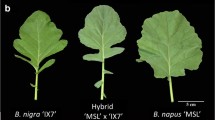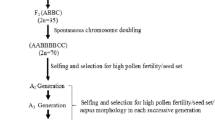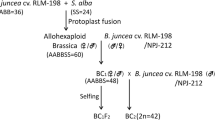Abstract
Yellow-seeded Brassica napus was for the first time developed from interspecific crosses using yellow-seeded B. juncea (AABB), yellow-seeded B. oleracea (CC), and black-seeded artificial B. napus (AACC). Three different mating approaches were undertaken to eliminate B-genome chromosomes after trigenomic hexaploids (AABBCC) were generated. Hybrids (AABCC, ABCC) from crosses AABBCC × AACC, AABBCC × CC and ABCC × AACC were advanced by continuous selfing in approach 1, 2 and 3, respectively. To provide more insight into Brassica genome evolution and the cytological basis for B. napus resynthesis in each approach, B-genome chromosome pairing and segregation were intensively analyzed in AABCC and ABCC plants using genomic in situ hybridization methods. The frequencies at which B-genome chromosomes underwent autosyndesis and allosyndesis were generally higher in ABCC than in AABCC plants. The difference was statistically significant for allosyndesis but not autosyndesis. Abnormal distributions of B-genome chromosomes were encountered at anaphase I, including chromosome lagging and precocious sister centromere separation of univalents. These abnormalities were observed at a significantly higher frequency in AABCC than in ABCC plants, which resulted in more rapid B-genome chromosome elimination in the AABCC derivatives. Yellow or yellow-brown seeds were obtained in all approaches, although true-breeding yellow-seeded B. napus was developed only in approaches 2 and 3. The efficiency of the B. napus construction approaches was in the order 1 > 3 > 2 whereas this order was 3 > 2 > 1 with respect to the construction of yellow-seeded B. napus. The results are discussed in relation to Brassica genome evolution and the development and utilization of the yellow-seeded B. napus obtained here.





Similar content being viewed by others
References
Aragón-Alcaide L, Reader S, Miller T, Moore G (1997) Centromeric behaviour in wheat with high and low homoeologous chromosomal pairing. Chromosoma 106:327–333
Arumugam N, Mukhopadhyay A, Gupta V, Pental D, Pradhan AK (1996) Synthesis of hexaploid (AABBCC) somatic hybrid: a bridging material for transfer of ‘tour’ cytoplasmic male sterility to different Brassica species. Theor Appl Genet 92:762–768
Attia T, Röbbelen G (1986) Cytogenetic relationship within cultivated Brassica analyzed in amphihaploids from the three diploid ancestors. Can J Genet Cytol 28:323–329
Attia T, Busso C, Röbbelen G (1987) Digenomic triploids for an assessment of chromosome relationships in the cultivated diploid Brassica species. Genome 29:326–330
Benavente E, Orellana J (1986) Differential anaphase I behavior between wheat and rye univalents in triticale—wheat hybrid plants. Genetics 69:161–166
Busso C, Attia T, Röbbelen G (1987) Trigenomic combinations for the analysis of meiotic control in the cultivated Brassica species. Genome 29:331–333
Chelysheva L, Diallo S, Vezon D, Gendrot G, Vrielynck N, Belcram K, Rocques N, Marquez-Lema A, Bhatt AM, Horlow C, Mercier R, Mezard C, Grelon M (2005) AtREC8 and AtSCC3 are essential to the monopolar orientation of the kinetochores during meiosis. J Cell Sci 118:4621–4632
Chen BY, Heneen WK (1992) Inheritance of seed colour in Brassica campestris L. and breeding for yellow-seeded B. napus L. Euphytica 59:157–163
Chen BY, Heneen WK, Jonsson R (1988) Resynthesis of Brassica napus L. through interspecific hybridization between B. alboglabra Bailey and B. rapa L. with special emphasis on seed colour. Plant Breed 101:52–59
Chen S, Nelson MN, Chèvre AM, Jenczewski E, Li ZY, Mason AS, Meng JL, Plummer JA, Pradhan A, Siddique KHM, Snowdon RJ, Yan GJ, Zhou WJ, Cowling WA (2011) Trigenomic bridges for Brassica improvement. Crit Rev Plant Sci 30:524–547
Choudhary BR, Joshi P, Ramarao S (2002) Cytogenetics of Brassica juncea × Brassica rapa hybrids and patterns of variation in the hybrid derivatives. Plant Breed 121:292–296
Clayberg CD (1959) Cytogenetic studies of precocious meiotic centromere division in Lycopersicon eseulentum Mill. Genetics 44:1335–1346
Del Bosco SF, Tusa N, Conicella C (1999) Microsporogenesis in a Citrus interspecific tetraploid somatic hybrid and its fusion parents. Heredity 83:373–377
Dewitte A, Eeckhaut T, Van Huylenbroeck J, Van Bockstaele E (2010) Meiotic aberrations during 2n pollen formation in Begonia. Heredity 104:215–223
Ge XH, Li ZY (2007) Intra- and intergenomic homology of B-genome chromosomes in trigenomic combinations of the cultivated Brassica species revealed by GISH analysis. Chromosome Res 15:849–861
Getinet A, Rakow G, Downey RK (1996) Agronomic performance and seed quality of Ethiopian mustard in Saskatchewan. Can J Plant Sci 76:387–392
Gladis T, Hammer K (2001) Nomenclatural note on the Brassica oleracea-group. Genet Resour Crop Evol 48:7–11
Hamant O, Golubovskaya I, Meeley R, Fiume E, Timofejeva L, Schleiffer A, Nasmyth K, Cande WZ (2005) A REC8-dependent plant shugoshin is required for maintenance of centromeric cohesion during meiosis and has no mitotic functions. Curr Biol 15:948–954
Jenczewski E, Eber F, Grimaud A, Huetb S, Lucasa MO, Monodb H, Chèvrea AM (2003) PrBn, a major gene controlling homeologous pairing in oilseed rape (Brassica napus) haploids. Genetics 164:645–653
Jiang CC, Ramchiary N, Ma YB, Jin M, Feng J, Li RY, Wang H, Long Y, Choi SR, Zhang CY, Cowling WA, Park BS, Lim YP, Meng JL (2011) Structural and functional comparative mapping between the Brassica A genomes in allotetraploid Brassica napus and diploid Brassica rapa. Theor Appl Genet 123:927–941
Lagercrantz U, Lydiate DJ (1996) Comparative genome mapping in Brassica. Genetics 144:1903–1910
Li Z, Liu HL, Luo P (1995) Production and cytogenetics of intergeneric hybrids between Brassica napus and Orychophragmus violaceus. Theor Appl Genet 91:131–136
Li MT, Qian W, Meng J, Li Z (2004) Construction of novel Brassica napus genotypes through chromosomal substitution and elimination using interploid species hybridization. Chromosome Res 12:417–426
Li MT, Li ZY, Zhang CY, Qian W, Meng JL (2005) Reproduction and cytogenetic characterization of interspecific hybrids derived from crosses between Brassica carinata and B. rapa. Theor Appl Genet 110:1284–1289
Li JN, Yin JM, Zhou QY, Lin N, Chen L, Chen SZ (2007) Agronomic performance and seed quality of a new source of yellow-seeded Brassica oleracea. In: Proceedings of 12th International Rapeseed Congress, Wuhan, China, 26–30 March, pp 114–116
Liu M, Li ZY (2007) Genome doubling and chromosome elimination with fragment recombination leading to the formation of Brassica rapa-type plants with genomic alterations in crosses with Orychophragmus violaceus. Genome 50:985–993
Lysak MA, Cheung K, Kitschke M, Bures P (2007) Ancestral chromosomal blocks are triplicated in Brassiceae species with varying chromosome number and genome size. Plant Physiol 145:402–410
Mason A, Huteau V, Eber F, Coriton O, Yan G, Nelson MN, Cowling WA, Che`vre AM (2010) Genome structure affects the rate of autosyndesis and allosyndesis in AABC, BBAC and CCAB Brassica interspecific hybrids. Chromosome Res 18:655–666
Mason A, Nelson MN, Castello MC, Yan GJ, Cowling WA (2011) Genotypic effects on the frequency of homoeologous and homologous recombination in Brassica napus × B. carinata hybrids. Theor Appl Genet 122:543–553
Mei J, Qian L, Disi JO, Yang X, Li Q, Li J, Frauen M, Cai D, Qian W (2011) Identification of resistant sources against Sclerotinia sclerotiorum in Brassica species with emphasis on B. oleracea. Euphytica 177:393–399
Meng JL, Shi SW, Gan L, Li ZY, Qu XS (1998) The production of yellow-seeded Brassica napus (AACC) through crossing interspecific hybrids of B. campestris (AA) and B. carinata (BBCC) with B. napus. Euphytica 103:329–333
Mithen RF, Lewis BG, Heaney RK, Fenwick GR (1987) Resistance of leaves of Brassica species to Leptosphaeria maculans. Trans Br Mycol Soc 88:525–531
Moore DP, Orr-Weaver TL (1998) Chromosome segregation during meiosis: building an unambivalent bivalent. Curr Top Dev Biol 37:263–299
Murashige T, Skoog F (1962) A revised medium for rapid growth and bioassays with tobacco tissue cultures. Plant Physiol 15:473–497
Navabi ZK, Stead KE, Pires JC, Xiong ZY, Sharpe AG, Parkin IAP, Rahman MH, Good AG (2011) Analysis of B-genome chromosome introgression in interspecific hybrids of Brassica napus × B. carinata. Genetics 187:659–673
Nelson MN, Mason AS, Castello MC, Thomson L, Yan G, Cowling WA (2009) Microspore culture preferentially selects unreduced (2n) gametes from an interspecific hybrid of Brassica napus L. × Brassica carinata Braun. Theor Appl Genet 119:497–505
Parkin I, Gulden S, Sharpe A, Lukens L, Trick M, Osborn T, Lydiate D (2005) Segmental structure of the Brassica napus genome based on comparative analysis with Arabidopsis thaliana. Genetics 171:765–781
Potapov DA, Osipova GM (2003) Development of yellow seeded Brassica napus in Siberia. In: Proceedings of 11th International Rapeseed Congress, vol 1, Copenhagen, 6–10 July, pp 250–252
Prakash S (1973) Haploidy in Brassica nigra Koch. Euphytica 22:613–614
Prakash S, Chopra VL (1988) Introgression of resistance to shattering in Brassica napus from Brassica juncea through non-homologous recombination. Plant Breeding 101:167–168
Qi CK, Fu SZ, Pu HM (1995) A successful transfer of yellow-seeded trait from Brassica carinata to B. napus. In: Proceedings of 8th International Rapeseed Congress, vol 4, Cambridge, 4–7 July, pp 1137–1140
Quiros CF (1999) Genome structure and mapping. In: Go′mez-Campo C (ed) Biology of Brassica Coenospecies. Elsevier, Amsterdam, pp 217–246
Rahman MH (2001) Production of yellow-seeded Brassica napus through interspecific crosses. Plant Breed 120:463–472
Rahman M (2007) Development of molecular markers for marker assisted selection for seed quality traits in oilseed rape. PhD Dissertation, University of Manitoba
Rahman H (2011) Untraditional approaches of interspecific hybridization in Brassica for introgression of traits from allied species. In: Proceedings of 13th International Rapeseed Congress, Prague, 5–9 June, pp 867–870
Rakow G, Raney JP, Relf-Eckstein J (1999) Agronmic performance and seed quality of a new source of yellow seeded Brasscia napus. In: Proceedings of the 10th International Rapeseed Congress Canberra, 26–29 September
Rakow G, Relf-Eckstein JA, Olson T (2011) Review and update on the development of yellow seed Brassica napus canola. p. 55. In: Abstract Book of 13th International Rapeseed Congress, Prague, 5–9 June
Rashid G, Rakow RK, Downey (1994) Development of yellow seeded Brassica napus through interspecific crosses. Plant Breed 112:127–134
Röbbelen G (1960) Beiträge zur Analyse des Brassica-Genomes. Chromosoma 11:205–228
Roy NN (1984) Interspecific transfer of Brassica juncea-type high blackleg resistance to Brassica napus. Euphytica 33:295–303
Slominski BA, Simbaya J, Campbell LD, Rakow G, Guenter W (1999) Nutritive value for broilers of meals derived from newly developed varieties of yellow-seeded canola. Anim Feed Sci Technol 78:249–262
Stringam GR, Mcgregor DI, Pawlowski SH (1974) Chemical and morphological characteristics associated with seed coat colour in rapeseed. In: Proceedings of 4th International Rapeseed Congress Giessen, 4–8 June, pp 9–108
Tang ZL, Li JN, Zhang XK, Chen L, Wang R (1997) Genetic variation of yellow-seeded rapeseed lines (Brassica napus L.) from different genetic sources. Plant Breed 116:471–474
Tonguc M, Griffiths PD (2004) Development of black rot resistant interspecific hybrids between Brassica oleracea L. cultivars and Brassica accession A 19182, using embryo rescue. Euphytica 136:313–318
U N (1935) Genome analysis on Brassica with special reference to the experimental formation of B. napus and peculiar mode of fertilization. Jpn J Bot 7:389–452
Watanabe Y (2004) Modifying sister chromatid cohesion for meiosis. J Cell Sci 117:4017–4023
Wen J, Tu JX, Li ZY, Fu TD, Ma CZ, Shen JX (2008) Improving ovary and embryo culture techniques for efficient resynthesis of Brassica napus from reciprocal crosses between yellow-seeded diploids B. rapa and B. oleracea. Euphytica 162:81–89
Woods DL, Capraca JJ, Downey RK (1991) The potential of mustard (Brassica juncea (L.) Coss.) as an edible oil crop on the Canadian prairies. Can J Plant Sci 71:195–198
Zhong XB, de Hans JJ, Zabel P (1996) Preparation of tomato meiotic pachytene and mitotic metaphase chromosomes suitable for fluorescence in situ hybridization (FISH). Chromosome Res 4:24–28
Zou J, Zhu JL, Huang SM, Tian ET, Xiao Y, Fu DH, Tu JX, Fu TD, Meng JL (2010) Broadening the avenue of intersubgenomic heterosis in oilseed Brassica. Theor Appl Genet 120:283–290
Acknowledgments
This research was financed by the High-Tech program ‘‘863’’ (2011AA10A104), the Program for Modern Agricultural Industrial Technology System (nycytx-00501) and the National Natural Science Foundation of China (31000721).
Author information
Authors and Affiliations
Corresponding author
Additional information
Communicated by I. Rajcan.
Electronic supplementary material
Below is the link to the electronic supplementary material.
Rights and permissions
About this article
Cite this article
Wen, J., Zhu, L., Qi, L. et al. Characterization of interploid hybrids from crosses between Brassica juncea and B. oleracea and the production of yellow-seeded B. napus . Theor Appl Genet 125, 19–32 (2012). https://doi.org/10.1007/s00122-012-1813-y
Received:
Accepted:
Published:
Issue Date:
DOI: https://doi.org/10.1007/s00122-012-1813-y




